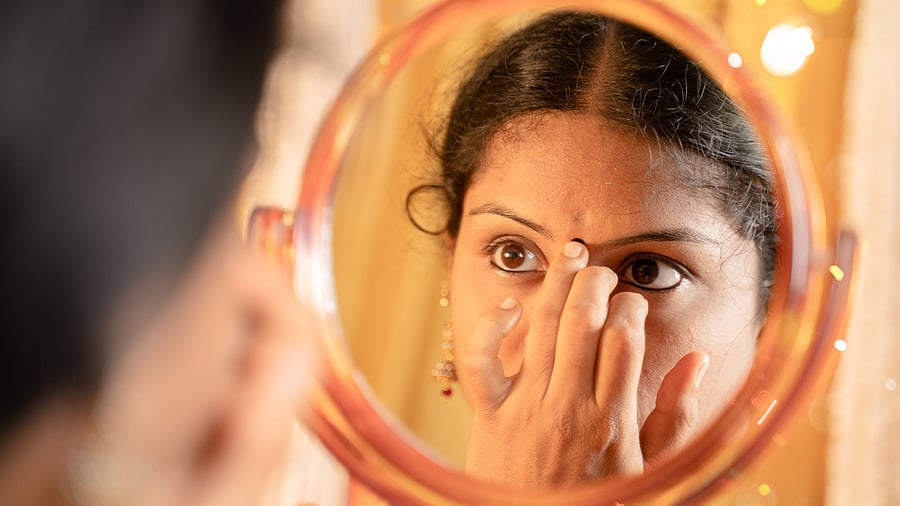
Bindi
Credit: iStock Photo
One can only wonder about the dot, seen or not seen, on the forehead of many Indian women that seems to preoccupy so many Indian men. In religious and cultural practices, Indian men also wear the bindi, as the area between the eyebrows where the bindi is positioned is said to be the ajna or sixth chakra, the repository of “concealed wisdom”. The bindi’s purpose is to retain energy and strengthen concentration, and the positioning is also said to represent the third eye mentioned in the Rig Veda.
Over time, the bindi evolved as the symbol of a married woman. The fact of the third eye, which is also seen as the eye of the Devil in Abrahamic religions, could be the reason that the bindi is avoided as a cultural practice by those who take this symbol literally.
But what is baffling is the obsession of Indian men with this dot. In recent times, Nitish Kumar, the chief minister of Bihar, was seen to make an unpleasant gesture towards the big bindi worn by Rabri Devi, Laloo Prasad’s wife and also an ex-chief minister of the state.
In recent times, a whole campaign for Diwali clothing called Jashn-e-Riwaaz had to be taken down by the company, after India’s new conscience keeper, X erupted with protests. The women in gorgeous finery were minus bindis, so an attempt was made to give the whole campaign a communal tinge, with the choice of an Urdu name compounding the problem. The objectification of the woman was complete with comparisons like a woman minus a bindi being like Mysore Pak without ghee or sambhar without drumsticks.
This is Woman’s History Month, so the wise guy who made those comparisons, as well as Nitish Kumar, may need a lesson in history and a reminder of the Dotbusters, a group of racist Americans who grouped together in the New Jersey area between 1975 and 1993 and went after Indian women in bindis and men too. They even published a threatening letter in the Jersey Journal that spoke of attacking Indians they see on the streets, breaking car windows and windows of houses and even crashing family parties. An attack on an Indian Parsi gentleman, Navroze Mody, resulted in grave injuries, a coma and then death. Mody’s father’s charges against the city of Hoboken, citing police indifference and asking for equal protection rights under the Fourteenth Amendment, were dismissed as the court ruled that there had been no proven hate crime.
This historical reference and the judgement merit mention, even more at a time when the whipping up of communal sentiments, either through references or gestures, can harm women or a community. Recent references by the chief minister of Maharashtra about digging up rioters from their graves to extract vengeance point at the strategy of a party that is always going back into history to find villains responsible for the plight of the Indians of today.
Women, of course, are the softest target, as the hijab controversy in Karnataka showed clearly. Everyone who was a subscriber to What’s App University had a strong opinion on the issue, and what was being done to young women in the name of imposing the hijab ban seemed to have completely missed people. The issue died down soon after the UP elections, which indicated an intent to fan communal differences.
Now the decision to have diplomatic ties with the Taliban flies in the face of the right-wing party’s concern for the Muslim woman. What is the purpose of working hard for her emancipation by ensuring that she does not have to face the imposition of the hijab or the triple talaq and yet spare no thought for the many Afghani women who are being forced to suffer the most stringent restrictions to their free movement, way of life and their rights as individuals? Are we missing something here?
When it involves a woman, it is always a case of damned if you do and damned if you don’t, or else why should one have to deal with men opining on the size of your bindi or the lack of it, or too many clothes as may be the hijab, or too little if it’s a mini, or the colours of the bikini worn by an actress in a movie?
For a party which endorses the Manusmriti and a country which has accultured its patriarchy, whatever the religion one professes, views on a woman’s sartorial preferences are just another form of control. The woman at the heart of it winds up a mere pawn in the game of identity politics.
(The author is an independent writer)